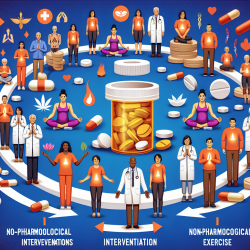Introduction
In the complex field of adolescent mental health, the intersection of post-traumatic stress disorder (PTSD) and substance use disorder (SUD) presents a significant challenge. The research article "Randomised controlled trial of integrated trauma-focused psychotherapy for traumatic stress and substance use among adolescents: trial protocol" offers a compelling protocol for addressing this dual diagnosis through an integrated therapeutic approach. This blog post will explore how practitioners can leverage these findings to enhance their therapeutic practice and improve outcomes for adolescents.
Understanding the Research
The study employs a rigorous randomized controlled trial (RCT) design to assess the efficacy of the Concurrent Treatment of PTSD and Substance Use Using Prolonged Exposure - Adolescent (COPE-A) compared to a supportive counselling control condition, Person-Centred Therapy (PCT). The trial involves 100 adolescents aged 12-18 years, aiming to provide evidence-based data on the effectiveness of integrated treatment for PTSD and SUD.
Key Findings and Implications
The research highlights several critical outcomes that practitioners should consider:
- Integrated Approach: Treating PTSD and SUD concurrently, rather than sequentially, can lead to significant reductions in PTSD symptoms and substance use, thereby breaking the cyclical relationship between the two disorders.
- Developmental Appropriateness: The COPE-A program is tailored to meet the unique developmental needs of adolescents, emphasizing motivational interviewing and emotion regulation, which are crucial for this age group.
- Long-term Efficacy: The study hypothesizes that improvements in PTSD and SUD symptoms will be maintained 12 months post-baseline, indicating the potential for lasting therapeutic benefits.
Practical Application for Practitioners
Practitioners can enhance their therapeutic interventions by incorporating the following strategies based on the study's findings:
- Adopt an Integrated Treatment Model: Consider implementing integrated treatment protocols like COPE-A, which address both PTSD and SUD simultaneously, to improve treatment outcomes.
- Focus on Developmental Needs: Tailor interventions to the developmental stage of adolescents, incorporating techniques such as motivational interviewing and emotion regulation to engage and support young clients effectively.
- Monitor Long-term Outcomes: Implement follow-up assessments to evaluate the sustainability of treatment effects and make necessary adjustments to therapeutic approaches.
Encouraging Further Research
The study underscores the need for further research to validate and expand upon these findings. Practitioners are encouraged to engage in or support research initiatives that explore integrated treatment models, contributing to the growing body of evidence necessary to refine and optimize therapeutic strategies for adolescents with PTSD and SUD.
To read the original research paper, please follow this link: Randomised controlled trial of integrated trauma-focused psychotherapy for traumatic stress and substance use among adolescents: trial protocol.










